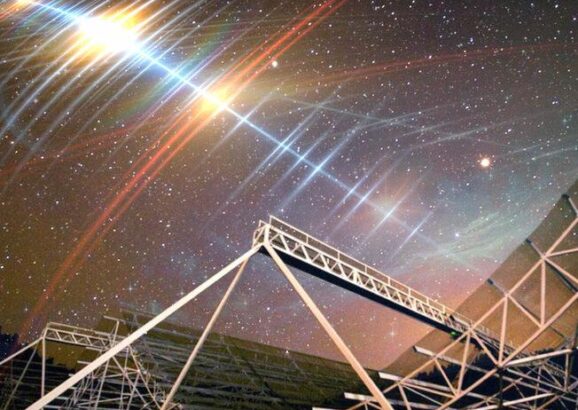Kiyoshi Masui
Research Interests
Professor Masui’s Synoptic Radio Lab works with wide-field, radio-wavelength sky surveys to establish new ways to observe the Universe. These include developing the technique of hydrogen intensity mapping for rapidly surveying large volumes of space, and exploiting the recently-discovered phenomena of fast radio bursts (FRBs) as probes of the Universe’s contents. This work includes creating digital instrumentation for radio telescopes, developing algorithms for analyzing observational data, and making theoretical predictions for the signals we should be looking for.
Hydrogen intensity mapping is a technique for rapidly surveying the large-scale distribution of matter in the Universe in three dimensions using radio emission from the 21-cm spectral line in hydrogen. Among the premier telescopes using this technique is the Canadian Hydrogen Intensity Mapping Experiment (CHIME), which is the main instrument used by Masui’s team. CHIME is part of a new generation of digital radio telescopes that have no moving parts and rely on signal processing software running on large compute clusters to focus and steer. This allows these telescopes to see large swaths of the sky simultaneously, enabling rapid surveys.
Fast radio bursts are brief and energetic flashes of radio light coming from distant galaxies. CHIME has been outfitted with a high-time-resolution backend dedicated to searching for FRBs, allowing it to detect these enigmatic transients at an unprecedented rate. Due to the unique properties of FRBs, they carry a record of the matter they’ve encountered between their source and our telescopes. Now, a central focus is to use the information contained in large samples of observed FRBs to help understand the evolution of the Universe.
Courtesy of Banff Centre for Arts and Creativity | YouTube
Biographical Sketch
Professor Masui studied engineering physics at Queen’s University in Canada and did his undergraduate thesis in experimental astroparticle physics. He received his PhD in physics in 2013 in the Canadian Institute for Theoretical Astrophysics (CITA) at the University of Toronto. For his graduate work he led one of the first radio surveys to use hydrogen to map large-scale structure beyond the local universe. He then moved to the University of British Columbia as a Canadian Institute for Advanced Research Global Scholar and subsequently a CITA National Fellow. He joined the MIT Department of Physics as an Assistant Professor in 2018.

Astronomers detect a radio “heartbeat” billions of light-years from Earth
The clear and periodic pattern of fast radio bursts may originate from a distant neutron star.
Awards & Honors
- 2022 // Lancelot M. Berkeley–New York Community Trust Prize for Meritorious Work in Astronomy (as part of CHIME/FRB team)
- 2019 // Teaching with Digital Technology Award, Nomination, MIT
- 2016-18 // Canadian Institute for Theoretical Astrophysics National Fellow
- 2013-15 // Canadian Institute for Advanced Research Global Scholar
- 2012-13 // Walter C. Sumner Memorial Fellowship, Walter C. Sumner Foundation
- 2012 // Van Kranendonk Teaching Award, University of Toronto Department of Physics
- 2010-12 // Alexander Graham Bell Canada Graduate Scholar—Doctoral, Natural Sciences and Engineering Research Council of Canada
- 2008-10 // Canada Graduate Scholar—Master’s, Natural Sciences and Engineering Research Council of Canada
Key Publications
-
K. W. Masui, U.-L. Pen, and N. Turok, “Two- and Three-Dimensional Probes of Parity in Primordial Gravity Waves”, Phys. Rev. Lett. 118, 221301 (2017), arXiv:1702.06552.
-
K. Masui, H.-H. Lin, J. Sievers, et al., “Dense magnetized plasma associated with a fast radio burst”, Nature 528, 523 (2015), arXiv:1512.00529.
-
K. W. Masui and K. Sigurdson, “Dispersion Distance and the Matter Distribution of the Universe in Dispersion Space”, Phys. Rev. Lett. 115, 121301 (2015), arXiv:1506.01704.
